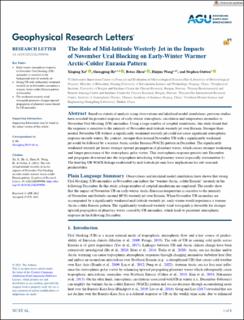| dc.contributor.author | Xu, Xinping | |
| dc.contributor.author | He, Shengping | |
| dc.contributor.author | Zhou, Botao | |
| dc.contributor.author | Wang, Huijun | |
| dc.contributor.author | Outten, Stephen | |
| dc.date.accessioned | 2022-10-04T14:03:59Z | |
| dc.date.available | 2022-10-04T14:03:59Z | |
| dc.date.created | 2022-09-30T10:35:59Z | |
| dc.date.issued | 2022 | |
| dc.identifier.issn | 0094-8276 | |
| dc.identifier.uri | https://hdl.handle.net/11250/3023671 | |
| dc.description.abstract | Based on statistical analysis using observations and idealized model simulations, previous studies have revealed the potential response of early-winter atmospheric circulation and temperature anomalies to November Ural blocking (UB) anomalies. Using a large number of coupled simulations, this study found that the response is sensitive to the intensity of November mid-latitude westerly jet over Eurasia. Stronger-than-normal November UB without a significantly weakened westerly jet could not cause significant atmospheric response in early-winter. By contrast, stronger-than-normal November UB with a significantly weakened jet would be followed by a warmer Arctic-colder Eurasia (WACE) pattern in December. The significantly weakened westerly jet favors stronger upward propagation of planetary waves, which causes stronger weakening and longer persistence of the stratospheric polar vortex. This stratospheric response persists into December and propagates downward into the troposphere interfering with planetary waves (especially wavenumber-1). The lead-lag UB-WACE linkage modulated by mid-latitude jet may have implications for sub-seasonal predictability. | en_US |
| dc.language.iso | eng | en_US |
| dc.publisher | American Geophysical Union | en_US |
| dc.rights | Navngivelse-IkkeKommersiell-Ingen bearbeidelser 4.0 Internasjonal | |
| dc.rights.uri | https://creativecommons.org/licenses/by-nc-nd/4.0/deed.no | |
| dc.title | The Role of Mid-latitude Westerly Jet in the Impacts of November Ural Blocking on Early-Winter Warmer Arctic-Colder Eurasia Pattern | en_US |
| dc.type | Journal article | en_US |
| dc.type | Peer reviewed | en_US |
| dc.description.version | publishedVersion | en_US |
| dc.rights.holder | Copyright 2022 the authors | en_US |
| dc.source.articlenumber | e2022GL099096 | en_US |
| cristin.ispublished | true | |
| cristin.fulltext | original | |
| cristin.qualitycode | 2 | |
| dc.identifier.doi | 10.1029/2022GL099096 | |
| dc.identifier.cristin | 2057077 | |
| dc.source.journal | Geophysical Research Letters | en_US |
| dc.identifier.citation | Geophysical Research Letters. 2022, 49 (16), e2022GL099096. | en_US |
| dc.source.volume | 49 | en_US |
| dc.source.issue | 16 | en_US |

